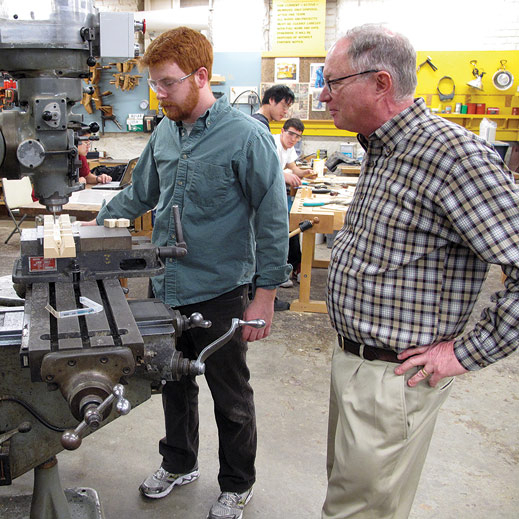Even on a campus renowned for making things, members of the MIT Hobby Shop have compiled an impressive record. Their projects have included furniture, kayaks, an airplane, wind-turbine generators, African drums, an electric cello, an autonomous submarine, decorative bowls, an iconic modernist clock, and a sculpture chosen for the Smithsonian American Art Museum’s permanent collection.

The Hobby Shop, which will observe its 75th anniversary in October, is a rarity on a university campus—a well-equipped workshop with open access for all students, alumni, faculty, and staff, plus their spouses. In addition to providing hand and machine tools, the unassuming basement room in W31 nurtures a diverse, creative community where ideas can be discussed, tested, and brought to life.
Ken Stone ’72, Hobby Shop director since 1991, says he and his tech instructor colleagues Brian Chan ’02 and Hayami Arakawa strive to make the shop useful to all 300 active members, who are about equally divided between men and women and range from veteran builders to new arrivals with no hands-on experience.
Excitement of Making Things
“Lots of people join because they have an immediate need, like drilling a hole. We show them how, and often that’s all it takes to get them excited about making things themselves,” explains Stone. “The shop instructors train people machine by machine, 10 or 15 minutes at a time, as opposed to having an elaborate course they have to take.” This approach helps newcomers move easily from basic handling of a saw or milling machine to advanced skills, like use of the digital controllers found on many of the shop’s tools.
At its 1938 founding, the Hobby Shop was a student club strictly for nonacademic projects. “The founders chose the name because they believed that a well-rounded individual pursued interests outside their profession,” says Stone. But in the Institute community, the line between professional and personal interests is often blurry, so the shop quickly began allowing work on any type of project.
That freedom has spawned brilliant careers. Chuck Jordan ’49 made a car model that won a 1947 General Motors contest; 45 years later he retired as GM’s VP of design. Rodney Regier ’72, now one of the world’s foremost re-creators of early keyboard instruments, constructed his first harpsichord at the shop. And Jerome Milgram ’61, SM ’62, PhD ’65, built two 17-foot racing sailboats before becoming an MIT professor of ocean engineering and a world-renowned yacht designer.
Shop members also uphold the Institute’s entrepreneurial tradition. Greg Schroll ‘08 founded Carbide Robotics to commercialize his prizewinning spherical robots, essentially balls that can be thrown into high-risk situations to provide reconnaissance; they were developed over many hours at a shop bench. The shop’s OMAX water-jet cutter was the birthplace of a ring-shaped LED cinematography light that led Michael Short ’05, SM ’10, PhD ’10, to found a company called LEDStorm. Short, now a research scientist in the Department of Nuclear Science and Engineering, remains an active shop user. He says Stone, Chan, and Arakawa “pretty much taught me what I know about making stuff.”
The water-jet cutter, one of the shop’s most versatile and popular tools, was co-designed by mechanical-engineering professor Alex Slocum ‘82, SM ‘83, PhD ‘85. A member for three decades, Slocum chairs the shop’s oversight committee within the Division of Student Life.
Fellow committee member Sam Allen, SM ’71, PhD ’75, Institute faculty chair and professor of physical metallurgy, has used the shop since 1971, making projects as small as a cutting board and as large as a 21-foot hollow sailboat mast. “Cutting pieces that long on the band saw was interesting,” he recalls. “So was getting it out of the shop!”
Wood, Metal, Plastics—and 3-D
Today’s focus is primarily on work with wood, metal, and plastics, but over the years the shop has supported ceramics, printing, photography, and radio electronics. The shop recently started offering 3-D printing capabilities, and Stone hopes to reintroduce welding following a much-needed renovation this summer, which will add more space, air conditioning, a computer room, and new lighting.
This past year students and alumni have stepped up their commitment to maintain the Hobby Shop. President Folkers Rojas ‘09, SM ‘11, a seven-year shop veteran and a doctoral student in mechanical engineering, says club members are now helping with machine repairs and upgrades and offering mentoring assistance to newcomers—calling to mind the way the student founders collected equipment and built cabinets for the original location in the basement of Building 2.
In its next 75 years—in an increasingly digital era—the Hobby Shop’s focus on tangible materials will have special value. “I tell my design students that having something in your hand will tell you things you never thought about,” says Rojas. “The hands-on experience that the Hobby Shop provides is an asset for engineers and scientists alike.”
Keep Reading
Most Popular
Large language models can do jaw-dropping things. But nobody knows exactly why.
And that's a problem. Figuring it out is one of the biggest scientific puzzles of our time and a crucial step towards controlling more powerful future models.
The problem with plug-in hybrids? Their drivers.
Plug-in hybrids are often sold as a transition to EVs, but new data from Europe shows we’re still underestimating the emissions they produce.
Google DeepMind’s new generative model makes Super Mario–like games from scratch
Genie learns how to control games by watching hours and hours of video. It could help train next-gen robots too.
How scientists traced a mysterious covid case back to six toilets
When wastewater surveillance turns into a hunt for a single infected individual, the ethics get tricky.
Stay connected
Get the latest updates from
MIT Technology Review
Discover special offers, top stories, upcoming events, and more.